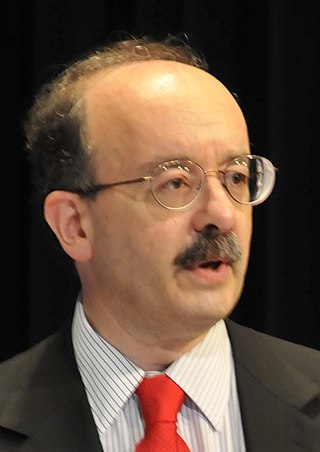The Hypercar is a design concept car developed by energy analyst Amory Lovins at the Rocky Mountain Institute. This vehicle would have ultra-light construction with an aerodynamic body using advanced composite materials, low-drag design, and hybrid drive. [1] Designers of the Hypercar claim that it would achieve a three- to five-fold improvement in fuel economy, equal or better performance, safety, amenity, and affordability, compared with today's cars. [2]
In 1994, the Rocky Mountain Institute (RMI) founded the Hypercar Center to help prove its technical feasibility and commercial reality. The concept was placed in the public domain to maximize competition in capturing its market and manufacturing advantages. The "Hypercar" would be a "hybrid electric/hydrogen-fuelled family vehicle that had only a few parts, was made of lightweight carbon but was stronger than steel, used existing technologies, weighed half a normal car of its size, and could travel the equivalent of 300 miles to the gallon. It was designed to have next to no emissions and, using its batteries, could become a power plant on wheels when parked, eliminating the need for nuclear or coal-power stations". [3]
In 1999, RMI took this process a step further by launching a for-profit venture, Hypercar Inc. This independent company, in which RMI has a minority interest, is now taking the lead in advancing key areas of Hypercar research and development. [4]
In 2004, Hypercar Inc. changed its name to Fiberforge to better reflect the company's new goal of lowering the cost of high-volume advanced-composite structures by leveraging the patents of David F. Taggart, one of the founders of Hypercar, Inc. [4]
Lovins says the commercialisation of the Hypercar began in 2014, with the production of the all-carbon electric BMW i3 family and the 313 miles per gallon Volkswagen XL1. [3]

A compressed-air car is a compressed-air vehicle powered by pressure vessels filled with compressed air. It is propelled by the release and expansion of the air within a motor adapted to compressed air. The car might be powered solely by air, or combined with other fuels such as gasoline, diesel, or an electric plant with regenerative braking.

A hydrogen vehicle is a vehicle that uses hydrogen to move. Hydrogen vehicles include some road vehicles, rail vehicles, space rockets, forklifts, ships and aircraft. Motive power is generated by converting the chemical energy of hydrogen to mechanical energy, either by reacting hydrogen with oxygen in a fuel cell to power electric motors or, less commonly, by hydrogen internal combustion.

Amory Bloch Lovins is an American writer, physicist, and former chairman/chief scientist of the Rocky Mountain Institute. He has written on energy policy and related areas for four decades, and served on the US National Petroleum Council, an oil industry lobbying group, from 2011 to 2018.

Fuel efficiency is a form of thermal efficiency, meaning the ratio of effort to result of a process that converts chemical potential energy contained in a carrier (fuel) into kinetic energy or work. Overall fuel efficiency may vary per device, which in turn may vary per application, and this spectrum of variance is often illustrated as a continuous energy profile. Non-transportation applications, such as industry, benefit from increased fuel efficiency, especially fossil fuel power plants or industries dealing with combustion, such as ammonia production during the Haber process.

A zero-emission vehicle, or ZEV, is a vehicle that does not emit exhaust gas or other pollutants from the onboard source of power. The California definition also adds that this includes under any and all possible operational modes and conditions. This is because under cold-start conditions for example, internal combustion engines tend to produce the maximum amount of pollutants. In a number of countries and states, transport is cited as the main source of greenhouse gases (GHG) and other pollutants. The desire to reduce this is thus politically strong.

The Rocky Mountain Institute, commonly abbreviated to RMI, is an organization in the United States co-founded by Amory Lovins dedicated to research, publication, consulting, and lecturing in the field of sustainability, with a focus on profitable innovations for energy and resource efficiency. RMI was established in 1982 and has grown into a broad-based institution with over 600 staff and an annual budget of $120+ million. RMI's work is independent and non-adversarial, with an emphasis on market-based solutions.

A compressed-air vehicle (CAV) is a transport mechanism fueled by tanks of pressurized atmospheric gas and propelled by the release and expansion of the gas within a pneumatic motor.

In 1976, energy policy analyst Amory Lovins coined the term soft energy path to describe an alternative future where energy efficiency and appropriate renewable energy sources steadily replace a centralized energy system based on fossil and nuclear fuels.

A fuel cell vehicle (FCV) or fuel cell electric vehicle (FCEV) is an electric vehicle that uses a fuel cell, sometimes in combination with a small battery or supercapacitor, to power its onboard electric motor. Fuel cells in vehicles generate electricity generally using oxygen from the air and compressed hydrogen. Most fuel cell vehicles are classified as zero-emissions vehicles. As compared with internal combustion vehicles, hydrogen vehicles centralize pollutants at the site of the hydrogen production, where hydrogen is typically derived from reformed natural gas. Transporting and storing hydrogen may also create pollutants. Fuel cells have been used in various kinds of vehicles including forklifts, especially in indoor applications where their clean emissions are important to air quality, and in space applications. Fuel cells are being developed and tested in trucks, buses, boats, ships, motorcycles and bicycles, among other kinds of vehicles.

The Monroney sticker or window sticker is a label required in the United States to be displayed in all new automobiles. It includes the listing of certain official information about the car. The window sticker was named after Almer Stillwell "Mike" Monroney, a United States Senator from Oklahoma.

The Honda Clarity is a nameplate used by Honda on alternative fuel vehicles. It was initially used only on hydrogen fuel-cell electric vehicles such as the 2008 Honda FCX Clarity, but in 2017 the nameplate was expanded to include the battery-electric Honda Clarity Electric and the plug-in hybrid electric Honda Clarity Plug-in Hybrid, in addition to the next generation Honda Clarity Fuel Cell. Clarity production ended in August 2021 with US leases for the fuel cell variant continuing through to 2022.
Hydrogen technologies are technologies that relate to the production and use of hydrogen as a part hydrogen economy. Hydrogen technologies are applicable for many uses.

An alternative fuel vehicle is a motor vehicle that runs on alternative fuel rather than traditional petroleum fuels. The term also refers to any technology powering an engine that does not solely involve petroleum. Because of a combination of factors, such as environmental and health concerns including climate change and air pollution, high oil-prices and the potential for peak oil, development of cleaner alternative fuels and advanced power systems for vehicles has become a high priority for many governments and vehicle manufacturers around the world.

CalCars was a charitable, non-profit organization founded in 2002 to promote plug-in hybrid electric vehicles (PHEVs) as a key to addressing oil dependence and global warming both nationally and internationally. It was active until 2010, when the first mass-produced PHEVs arrived. CalCars envisioned millions of plug-in hybrid electric vehicles, charged by off-peak electricity from renewable energy sources, and with their internal combustion engines powered by low-carbon alternative fuels, as a way to significantly reduce greenhouse gases that come from transportation.

Winning the Oil Endgame: Innovation for Profits, Jobs and Security is a 2005 book by Amory B. Lovins, E. Kyle Datta, Odd-Even Bustnes, Jonathan G. Koomey, and Nathan J. Glasgow, published by the Rocky Mountain Institute. It presents an independent, transdisciplinary analysis of four ways to reduce petroleum dependence in the United States:
Felix Kramer is an entrepreneur, strategist and writer. After a succession of jobs and projects in the nonprofit sector and an early internet startup, he gained attention after 2002 as the founder of the California Cars Initiative, promoting mass production of plug-in hybrid electric vehicles. Since 2009, he has written broadly on climate change awareness and solutions, and collaborated on or co-founded climate-related projects.
Fiberforge was a privately held company, started in 1998. The company uses a proprietary process for making thermoplastic advanced composites to make things more lightweight. Particular interest has been placed on decreasing weight of everyday means of transportation like cars and aircraft for better fuel efficiency and hence Environmental sustainability. Amory Lovins was its chairman emeritus.
RONN Motor Group (RONN) is an automaker based in Scottsdale, Arizona.

Bright Automotive was a startup company in Anderson, Indiana, working to create a fuel-efficient line of plug-in electric vehicles. The company was started in 2008 with a team of employees from former companies such as Chrysler, Delphi, GM, Mazda, and Toyota. The company designed its first vehicle, the IDEA, a plug-in hybrid electric fleet vehicle designed to reduce fuel costs for corporations that maintain a large commercial fleet. Bright also had a service branch called eSolutions that focused on speeding up the process of car electrification with consulting and conversions. Bright's last CEO, Reuben Munger, stated in early press releases that he wished to see the IDEA in production by 2013.
The University of Kansas Sustainable Automotive Energy Infrastructure Initiative, or more commonly referred to as the KU Ecohawks is an ongoing project that works to promote sustainability in the automotive sector. Founded during the beginning of the Automotive industry crisis of 2008–2010 in the U.S., the group recycles old vehicles to run on community wastes and renewables, especially on the University of Kansas campus and not rely on conventional fossil fuel sources that pollute the local and global environment.